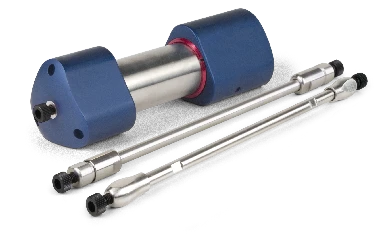
High Performance Liquid Chromatography (HPLC)
What Is HPLC?
High-Performance Liquid Chromatography (HPLC) is an analytical technique used to separate, identify, and quantify components in complex mixtures. Operating typically at pressures below 6,000 psi, HPLC systems pump a liquid mobile phase through a column packed with fine stationary-phase particles, usually 3–10 µm in diameter. These particles create extensive surface area for interaction between analytes and the stationary phase, enabling efficient and reproducible separations. By precisely controlling mobile-phase composition, flow rate, and temperature—and coupling the system with sensitive detectors—HPLC provides high-resolution and quantitative results across diverse applications, including drug identity confirmation, purity testing, and therapeutic monitoring.

How Do HPLC Columns Work?
HPLC columns are engineered to separate complex mixtures into individual components with high precision. Inside each column, the stationary phase interacts with analytes as they are carried through by the mobile phase under high pressure. The effectiveness of this separation depends on selecting the right combination of column chemistry, particle size, and mobile phase conditions. By fine-tuning these variables, scientists can achieve optimal resolution, sensitivity, and reproducibility for a wide range of analytical applications.
Benefits of HPLC
- Robustness & Reliability – HPLC systems are extremely durable, less sensitive to minor pressure fluctuations, and can handle “dirtier” samples (like food, environmental, or plant extracts) without clogging as easily.
- Method Transferability – Most regulatory and compendial methods (USP, EP, JP) are written for HPLC, making it the default platform in QC and regulated environments.
- Cost Efficiency – HPLC instruments, columns, and maintenance are generally less expensive. UHPLC columns and hardware can be more costly and cn wear faster under high pressure.
- Sample Load Capacity – Because HPLC columns typically use larger particle sizes (3–5 µm), they often tolerate higher injection volumes, which can be useful for preparative work or when analytes are at low concentrations.
- Ease of Use – HPLC has broader accessibility; analysts may prefer it for routine, high-throughput work where speed isn’t the primary concern.
How to Choose the Correct HPLC Column?
- Sample Properties: Understand the properties of the sample being analyzed, such as polarity, size, and chemical nature. Match these characteristics with the appropriate stationery phase chemistry and column type.
- Analyte Stability: Consider the stability of the analytes during the separation process. Choose column and mobile phase conditions that minimize degradation or internation with the stationary phase.
- Separation Objective: Determine the specific compounds or classes of compounds you need to separate and analyze. Select a column type that provides the required selectivity, resolution, and efficiency for your application.
- Column Dimensions: Consider the dimensions of the column, including length, diameter, and particle size. Longer columns with smaller particle size typically offer higher resolution, but may require longer analysis times.
- Mobile Phase Compatibility: Ensure compatibility between the mobile phase and stationary phase chemistry to prevent interactions that could affect separtion efficiency and column performance.
- Sample Matrix: Consider the composition of the sample matrix and potential interferences. Choose a column that can effectively separate the target analytes from matrix components.
- Budget and Resources: Consider practical factors such as budget constraints, availability of columns, and equipment compatibility.
HPLC Column Types
Shop by HPLC Column Brands
Particle Types
Understanding Mobile and Stationary Phases
In HPLC, separation depends on the interaction between two key components—the mobile phase and the stationary phase.
Mobile Phase
The mobile phase is a liquid solvent or solvent mixture that transports analytes through the HPLC column. Its composition – solvent type, pH, and bugger concentration – directly affects separation efficiency, resolution, and selectivity. Common solvents include water, acetonitrile, methanol, and buffered solutions, chosen based on the analyte’s properties. Optimizing the mobile phase is key to achieving reliable and high-performance chromatographic results.
Stationary Phase
The stationary phase is the material packed inside the HPLC column where analytes are separated based on their chemical properties. It interacts with analytes through differences in polarity, size, charge, and other chemical properties. Common types include reversed-phase, normal-phase, ion exchange, and affinity chromatography. Materials are typically silica-based or polymeric, select to match the application and desired separation.
Phenomenex offers a comprehensive range of high-performance HPLC columns—including Biologics, Oligonucleotide, Core-Shell, Chiral, and Omega Robust High-Performance options—to meet diverse application needs. Not sure which column is right for you? Our live chat team is ready to help you find the perfect fit.




















